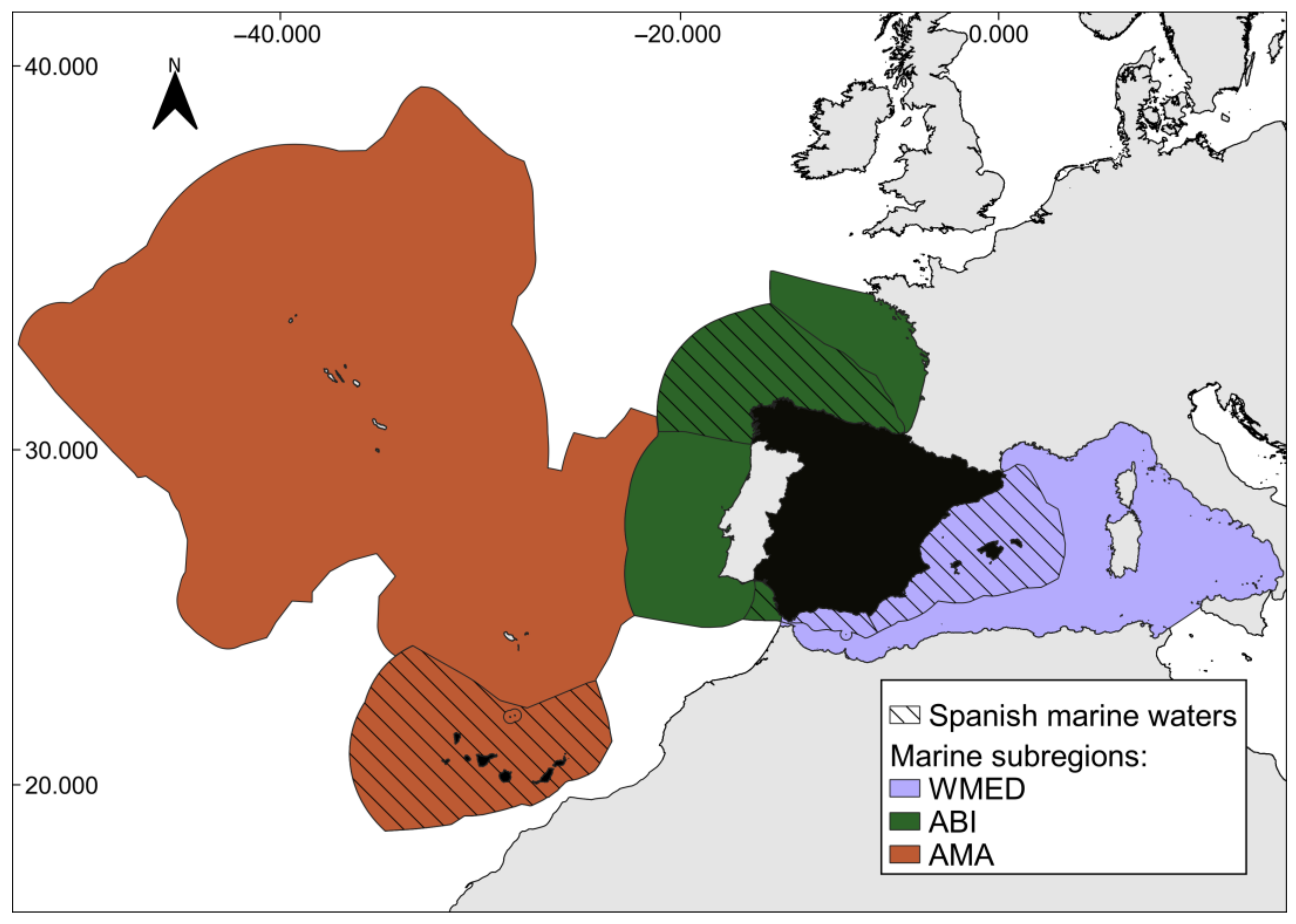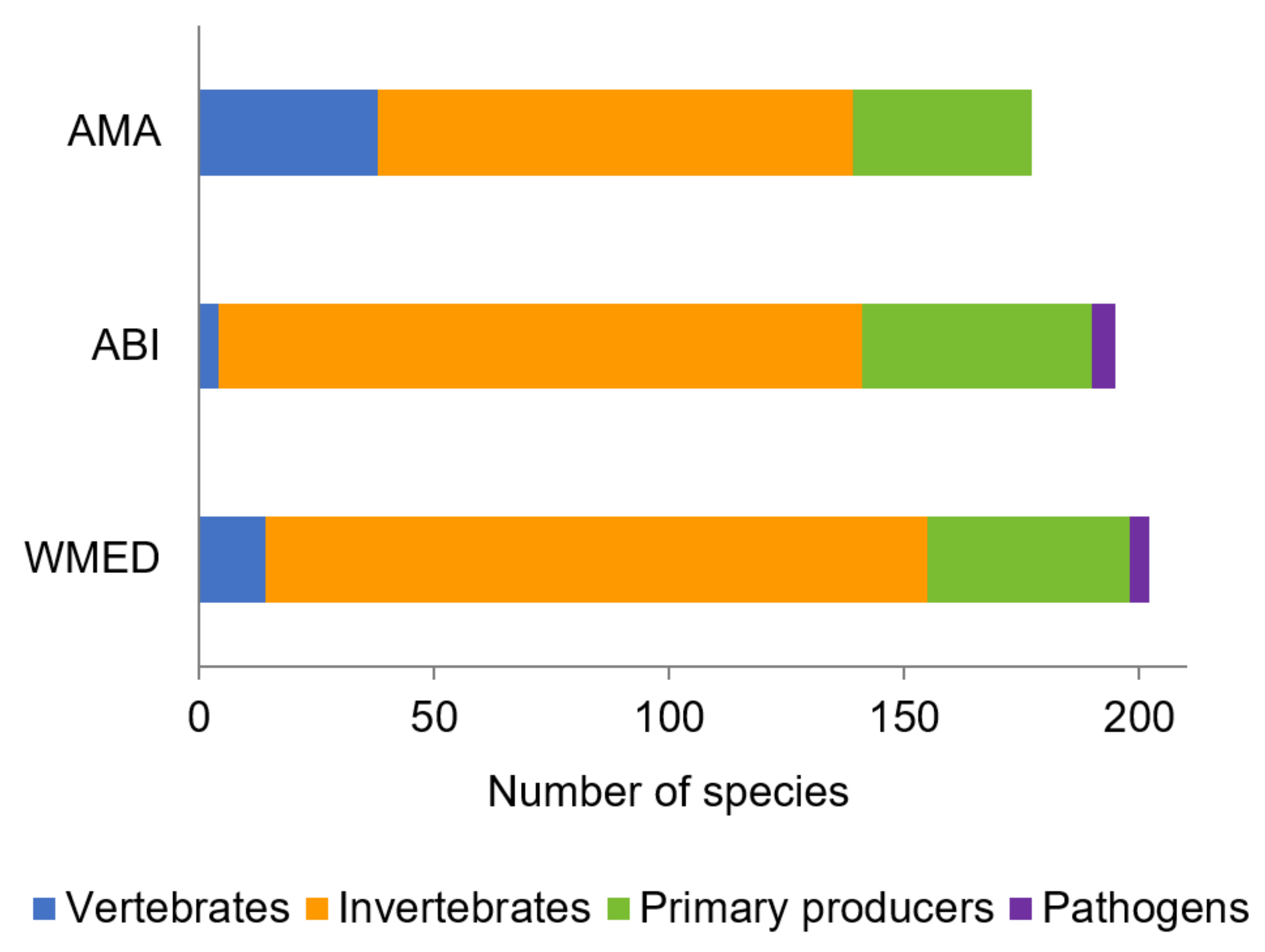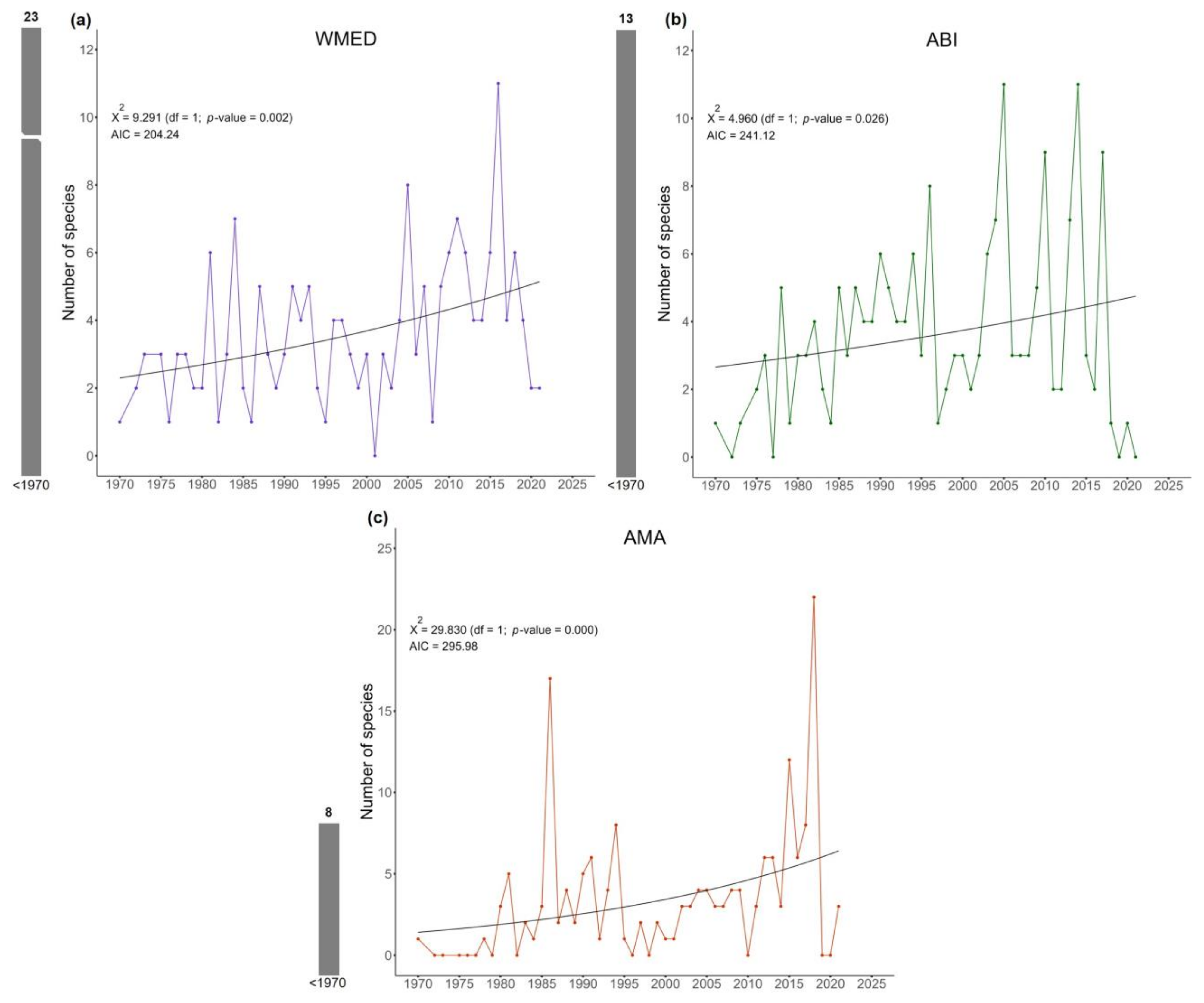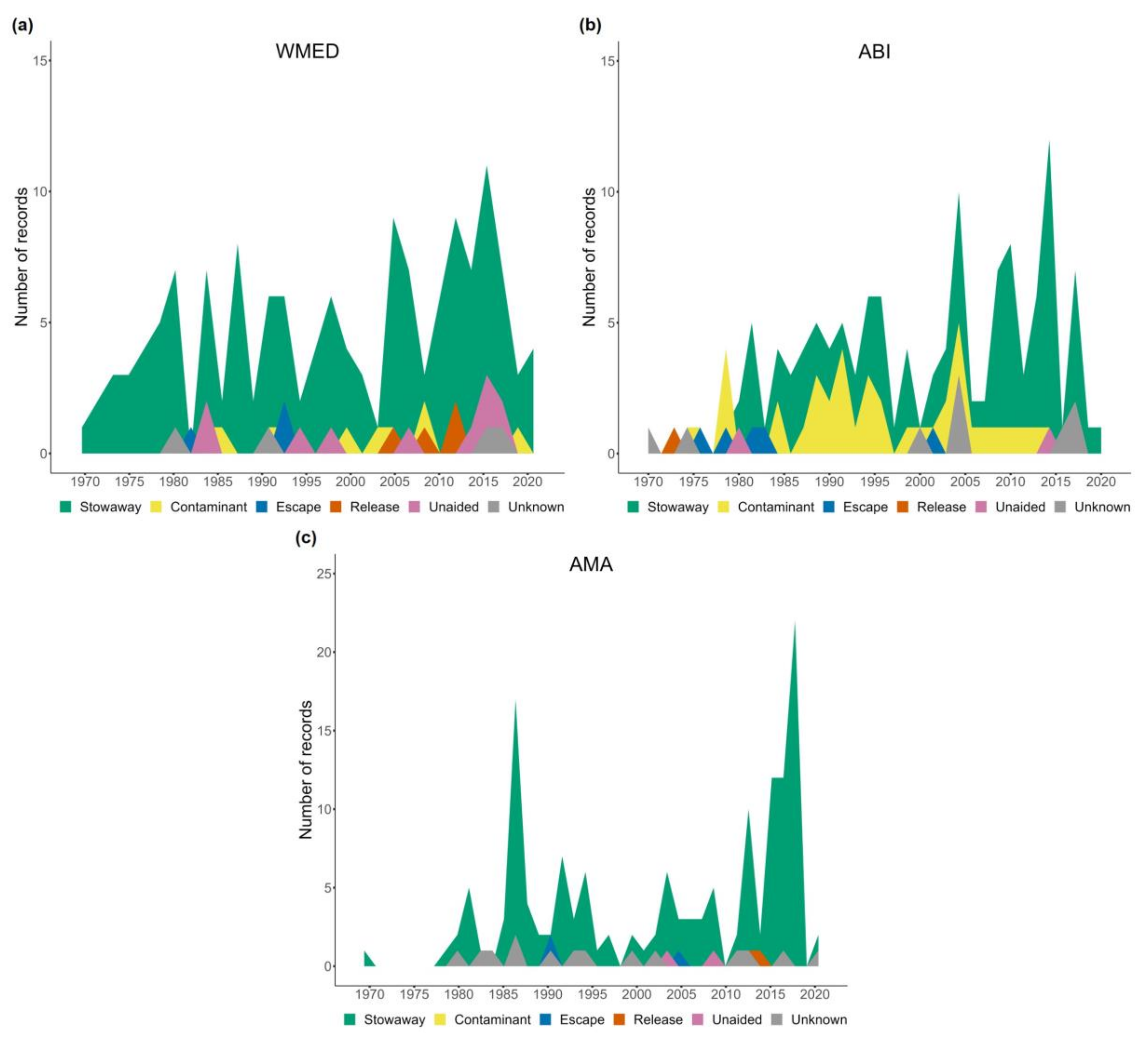Updating the National Baseline of Non-Indigenous Species in Spanish Marine Waters
Abstract
1. Introduction
2. Materials and Methods
3. Results
4. Discussion and Conclusions
Supplementary Materials
Author Contributions
Funding
Data Availability Statement
Acknowledgments
Conflicts of Interest
References
- Nunes, A.L.; Katsanevakis, S.; Zenetos, A.; Cardoso, A.C. Gateways to alien invasions in the European seas. Aquat. Invasions 2014, 9, 133–144. [Google Scholar] [CrossRef]
- Campbell, M.L.; King, S.; Heppenstall, L.D.; van Gool, E.; Martin, R.; Hewitt, C.L. Aquaculture and urban marine structures facilitate native and non-indigenous species transfer through generation and accumulation of marine debris. Mar. Pollut. Bull. 2017, 123, 304–312. [Google Scholar] [CrossRef] [PubMed]
- Molnar, J.L.; Gamboa, R.L.; Revenga, C.; Spalding, M.D. Assessing the global threat of invasive species to marine biodiversity. Front. Ecol. Environ. 2008, 6, 485–492. [Google Scholar] [CrossRef]
- Katsanevakis, S.; Wallentinus, I.; Zenetos, A.; Leppäkoski, E.; Çinar, M.E.; Oztürk, B.; Grabowski, M.; Golani, D.; Cardoso, A.C. Impacts of invasive alien marine species on ecosystem services and biodiversity: A pan-European review. Aquat. Invasions 2014, 9, 391–423. [Google Scholar] [CrossRef]
- Giakoumi, S.; Katsanevakis, S.; Albano, P.G.; Azzurro, E.; Cardoso, A.C.; Cebrian, E.; Deidun, A.; Edelist, D.; Francour, P.; Jimenez, C.; et al. Management priorities for marine invasive species. Sci. Total Environ. 2019, 688, 976–982. [Google Scholar] [CrossRef] [PubMed]
- Bédry, R.; de Haro, L.; Bentur, Y.; Senechal, N.; Galil, B.S. Toxicological risks on the human health of populations living around the Mediterranean Sea linked to the invasion of non-indigenous marine species from the Red Sea: A review. Toxicon 2021, 191, 69–82. [Google Scholar] [CrossRef] [PubMed]
- Ramus, A.P.; Silliman, B.R.; Thomsen, M.S.; Long, Z.T. An invasive foundation species enhances multifunctionality in a coastal ecosystem. Proc. Natl. Acad. Sci. USA 2017, 114, 8580–8585. [Google Scholar] [CrossRef]
- Katsanevakis, S.; Rilov, G.; Edelist, D. Impacts of marine invasive alien species on European fisheries and aquaculture—Plague or boon? In Engaging Marine Scientists and Fishers to Share Knowledge and Perceptions—Early Lessons; CIESM Workshop Monograph n° 50; Briand, F., Ed.; CIESM Publisher: Monaco City, Monaco; Paris, France, 2018; pp. 125–132. [Google Scholar]
- Mancinelli, G.; Chainho, P.; Cilenti, L.; Falco, S.; Kapiris, K.; Katselis, G.; Ribeiro, F. On the Atlantic blue crab (Callinectes sapidus Rathbun 1896) in southern European coastal waters: Time to turn a threat into a resource? Fish. Res. 2017, 194, 1–8. [Google Scholar] [CrossRef]
- Vimercati, G.; Kumschick, S.; Probert, A.F.; Volery, L.; Bacher, S. The importance of assessing positive and beneficial impacts of alien species. NeoBiota 2020, 62, 525–545. [Google Scholar] [CrossRef]
- Tsirintanis, K.; Azzurro, E.; Crocetta, F.; Dimiza, M.; Froglia, C.; Gerovasileiou, V.; Langeneck, J.; Mancinelli, G.; Rosso, A.; Stern, N.; et al. Bioinvasion impacts on biodiversity, ecosystem services, and human health in the Mediterranean Sea. Aquat. Invasions 2022, 17, 308–352. [Google Scholar] [CrossRef]
- Castro, N.; Carlton, J.T.; Costa, A.C.; Marques, C.; Hewitt, C.L.; Cacabelos, E.; Gizzi, F.; Gestoso, I.; Monteiro, J.G.; Costa, J.L.; et al. Diversity and patterns of marine non-native species in the archipelagos of Macaronesia. Divers. Distrib. 2022, 28, 667–684. [Google Scholar] [CrossRef]
- Galanidi, M.; Zenetos, A. Data-driven recommendations for establishing threshold values for the NIS trend indicator in the Mediterranean Sea. Diversity 2022, 14, 57. [Google Scholar] [CrossRef]
- Zenetos, A.; Tsiamis, K.; Galanidi, M.; Carvalho, N.; Bartilotti, C.; Canning-Clode, J.; Castriota, L.; Chainho, P.; Comas-González, R.; Costa, A.C.; et al. Status and trends in the rate of introduction of marine non-indigenous species in European seas. Diversity 2022, 14, 1077. [Google Scholar] [CrossRef]
- Tsiamis, K.; Palialexis, A.; Stefanova, K.; Gladan, Ž.N.; Skejić, S.; Despalatović, M.; Cvitković, I.; Dragičević, B.; Dulčić, J.; Vidjak, O.; et al. Non-indigenous species refined national baseline inventories: A synthesis in the context of the European Union’s Marine Strategy Framework Directive. Mar. Pollut. Bull. 2019, 145, 429–435. [Google Scholar] [CrossRef] [PubMed]
- Tsiamis, K.; Palialexis, A.; Connor, D.; Antoniadis, S.; Bartilotti, C.; Bartolo, A.G.; Berggreen, U.C.; Boschetti, S.; Buschbaum, C.; Canning-Clode, J.; et al. Marine Strategy Framework Directive- Descriptor 2, Non-Indigenous Species, Delivering Solid Recommendations for Setting Threshold Values for Non-Indigenous Species Pressure on European Seas; Publication Office of the European Union: Luxembourg, 2021; Available online: https://data.europa.eu/doi/10.2760/035071 (accessed on 21 March 2023).
- World Register of Marine Species. Available online: https://www.marinespecies.org (accessed on 21 March 2023).
- European Commission—Joint Research Centre—European Alien Species Information Network (EASIN). Available online: https://easin.jrc.ec.europa.eu/ (accessed on 21 March 2023).
- UNEP/MAP. Baseline for the IMAP Common Indicator 6 Related to Non-Indigenous Species (UNEP/MED WG.520/5); UNEP: Nairobi, Kenya, 2022. [Google Scholar]
- Convention on Biological Diversity. Pathways of Introduction of Invasive Species, Their Prioritization and Management. (UNEP/CBD/SBSTTA/18/9/Add.1). Subsidiary Body on Scientific, Technical and Technological Advice, Montreal. 2014. Available online: https://www.cbd.int/doc/meetings/sbstta/sbstta-18/official/sbstta-18-09-add1-en.pdf (accessed on 21 March 2023).
- Pergl, J.; Brundu, G.; Harrower, C.A.; Cardoso, A.C.; Genovesi, P.; Katsanevakis, S.; Lozano, V.; Perglová, I.; Rabitsch, W.; Richards, G.; et al. Applying the Convention on Biological Diversity Pathway Classification to alien species in Europe. NeoBiota 2020, 62, 333–363. [Google Scholar] [CrossRef]
- R Core Team. R: A Language and Environment for Statistical Computing; R Foundation for Statistical Computing: Vienna, Austria, 2022; Available online: https://www.r-project.org (accessed on 21 March 2023).
- Posit Team. RStudio: Integrated Development Environment for R; Posit Software: Boston, MA, USA, 2023; Available online: http://www.posit.co (accessed on 21 March 2023).
- Wickham, H.; Averick, M.; Bryan, J.; Chang, W.; McGowan, L.D.; François, R.; Grolemund, G.; Hayes, A.; Henry, L.; Hester, J.; et al. Welcome to the tidyverse. J. Open Source Softw. 2019, 4, 1686. [Google Scholar] [CrossRef]
- Zenetos, A.; Albano, P.G.; López Garcia, E.; Stern, N.; Tsiamis, K.; Galanidi, M. Established non-indigenous species increased by 40% in 11 years in the Mediterranean Sea. Mediterr. Mar. Sci. 2022, 23, 196–212. [Google Scholar] [CrossRef]
- Massé, C.; Viard, F.; Humbert, S.; Antajan, E.; Auby, I.; Bachelet, G.; Bernard, G.; Bouchet, V.M.P.; Burel, T.; Dauvin, J.-C.; et al. An Overview of Marine Non-Indigenous Species Found in Three Contrasting Biogeographic Metropolitan French Regions: Insights on Distribution, Origins and Pathways of Introduction. Diversity 2023, 15, 161. [Google Scholar] [CrossRef]
- Ferrario, J.; Caronni, S.; Occhipinti-Ambrogi, A.; Marchini, A. Role of commercial harbours and recreational marinas in the spread of non-indigenous fouling species. Biofouling 2017, 33, 651–660. [Google Scholar] [CrossRef]
- Falcón, J.M. Ictiofauna de las Islas Canarias. Análisis Biogeográfico. Ph.D. Thesis, Universidad de La Laguna, Santa Cruz de Tenerife, Spain, 2015. [Google Scholar]
- Pajuelo, J.G.; González, J.A.; Triay-Portella, R.; Martín, J.A.; Ruiz-Díaz, R.; Lorenzo, J.M.; Luque, A. Introduction of non-native marine fish species to the Canary Islands waters through oil platforms as vectors. J. Mar. Syst. 2016, 163, 23–30. [Google Scholar] [CrossRef]
- Brito, A.; Clemente, S.; Herrera, R. On the occurrence of the African hind, Cephalopholis taeniops, in the Canary Islands (eastern subtropical Atlantic): Introduction of large-sized demersal littoral fishes in ballast water of oil platforms? Biol. Invasions 2011, 13, 2185–2189. [Google Scholar] [CrossRef]
- Falcón, J.M.; Herrera, R.; Ayza, O.; Brito, A. New species of tropical litoral fish found in Canarian waters. Oil platforms as a central introduction vector. Rev. Acad. Canar. Cienc. 2015, 27, 67–82. [Google Scholar]
- Falcón, J.M.; Brito, A.; Herrera, R.; Monterroso, O.; Rodríguez, M.; Álvarez, O.; Ramos, E.; Miguel, A. New records of tropical littoral fishes from the Canary Islands as a result of two driving forces: Natural expansion and introduction by oil platforms. Rev. Acad. Canar. Cienc. 2018, 30, 39–56. [Google Scholar]
- López, C.; Clemente, S.; Moreno, S.; Ocaña, O.; Herrera, R.; Moro, L.; Monterroso, O.; Rodríguez, A.; Brito, A. Invasive Tubastraea spp. and Oculina patagonica and other introduced scleractinians corals in the Santa Cruz de Tenerife (Canary Islands) harbor: Ecology and potential risks. Reg. Stud. Mar. Sci. 2019, 29, 100713. [Google Scholar] [CrossRef]
- Triay-Portella, R.; Martín, J.A.; Luque, L.; Pajuelo, J.G. Relevance of feeding ecology in the management of invasive species: Prey variability in a novel invasive crab. Estuar. Coast. Shelf Sci. 2022, 274, 107949. [Google Scholar] [CrossRef]
- Png-Gonzalez, L.; Andrade, C.; Abramic, A.; Nogueira, N. Analysis of the Aquaculture Industry in Macaronesia under MSFD. Technical Report for PLASMAR Project. 2019. Available online: http://hdl.handle.net/10553/55195 (accessed on 20 March 2023).
- Bianchi, C.; Caroli, F.; Guidetti, P.; Morri, C. Seawater warming at the northern reach for southern species: Gulf of Genoa, NW Mediterranean. J. Mar. Biolog. Assoc. UK 2018, 98, 1–12. [Google Scholar] [CrossRef]
- Fortič, A.; Al-Sheikh Rasheed, R.; Almajid, Z.; Badreddine, A.; Báez, J.C.; Belmonte-Gallegos, A.; Bettoso, N.; Borme, D.; Camisa, F.; Caracciolo, D.; et al. New records of introduced species in the Mediterranean Sea (April 2023). Mediterr. Mar. Sci. 2023, 24, 182–202. [Google Scholar] [CrossRef]
- Korpinen, S.; Klančnik, K.; Peterlin, M.; Nurmi, M.; Laamanen, L.; Zupančič, G.; Popit, A.; Murray, C.; Harvey, T.; Andersen, J.H.; et al. Multiple Pressures and Their Combined Effects in Europe’s Seas; European Topic Centre on Inland, Coastal and Marine Waters: Magdeburg, Germany, 2019. [Google Scholar]
- Corsini-Foka, M.; Zenetos, A.; Crocetta, F.; Cinar, M.E.; Kocak, F.; Golani, D.; Katsanevakis, S.; Tsiamis, K.; Cook, E.; Froglia, C.; et al. Inventory of alien and cryptogenic species of the Dodecanese (Aegean Sea, Greece): Collaboration through COST action training school. Manag. Biol. Invasions 2015, 6, 351–366. [Google Scholar] [CrossRef]
- Staehr, P.A.; Jakobsen, H.H.; Hansen, J.L.; Andersen, P.; Christensen, J.; Göke, C.; Thomsen, M.S.; Stebbing, P.D. Trends in records and contribution of non-indigenous and cryptogenic species to marine communities in Danish waters: Potential indicators for assessing impact. Aquat. Invasions 2020, 15, 127–244. [Google Scholar] [CrossRef]
- Díaz-Tapia, P.; Bárbara, I.; Cremades, J.; Verbruggen, H.; Maggs, C.A. Three new cryptogenic species in the tribes Polysiphonieae and Streblocladieae (Rhodomelaceae, Rhodophyta). Phycologia 2017, 56, 605–623. [Google Scholar] [CrossRef]
- Katsanevakis, S.; Tsirintanis, K.; Tsaparis, D.; Doukas, D.; Sini, M.; Athanassopoulou, F.; Kolygas, M.N.; Tontis, D.; Koutsoubas, D.; Bakopoulos, V. The cryptogenic parasite Haplosporidium pinnae invades the Aegean Sea and causes the collapse of Pinna nobilis populations. Aquat. Invasions 2019, 14, 150–164. [Google Scholar] [CrossRef]
- Haydar, D. What is natural? The scale of cryptogenesis in the North Atlantic Ocean. Divers. Distrib. 2012, 18, 101–110. [Google Scholar] [CrossRef]
- Zibrowius, H. Oculina patagonica, Scléractiniaire hermatypique introduit en Méditerranée. Helgol. Wissenschaftliche Meeresunters. 1974, 26, 153–173. [Google Scholar] [CrossRef]
- Fine, M.; Zibrowius, H.; Loya, Y. Oculina patagonica: A non-lessepsian scleractinian coral invading the Mediterranean Sea. Mar. Biol. 2001, 138, 1195–1203. [Google Scholar] [CrossRef]
- Salomidi, M.; Katsanevakis, S.; Issaris, Y.; Tsiamis, K.; Katsiaras, N. Anthropogenic disturbance of coastal habitats promotes the spread of the introduced scleractinian coral Oculina patagonica in the Mediterranean Sea. Biol. Invasions 2013, 15, 1961–1971. [Google Scholar] [CrossRef]
- Zibrowius, H.; Ramos-Esplá, A.A. Oculina patagonica, scléractiniaire exotique en Méditerranée—nouvelles observations dans le Sud-Est de l’Espagne. Rapp. CIESM 1983, 28, 297–301. [Google Scholar]
- Serrano, E.; Ribes, M.; Coma, R. Demographics of the zooxanthellate coral Oculina patagonica along the Mediterranean Iberian coast in relation to environmental parameters. Sci. Total Environ. 2018, 634, 1580–1592. [Google Scholar] [CrossRef]
- Leydet, K.P.; Hellberg, M.E. The invasive coral Oculina patagonica has not been recently introduced to the Mediterranean from the western Atlantic. BMC Evol. Biol. 2015, 15, 79. [Google Scholar] [CrossRef]
- Zenetos, A.; Çinar, M.E.; Crocetta, F.; Golani, D.; Rosso, A.; Servello, G.; Shenkar, N.; Turon, X.; Verlaque, M. Uncertainties and validation of alien species catalogues: The Mediterranean as an example. Estuar. Coast. Shelf Sci. 2017, 191, 171–187. [Google Scholar] [CrossRef]
- Brito, A.; López, C.; Ocaña, O.; Herrera, R.; Moro, L.; Monterroso, O.; Rodríguez, A.; Clemente, S.; Sánchez, J.J. Colonization and expansion of two potentially invasive coral species in the Canary Islands introduced through oil platforms. Vieraea 2017, 45, 65–82. [Google Scholar] [CrossRef]
- Gofas, S.; Luque, A.A.; Templado, J.; Salas, C. A national checklist of marine Mollusca in Spanish waters. Sci. Mar. 2017, 81, 241–254. [Google Scholar] [CrossRef]
- Bañón, R.; Rolán, E.; García-Tasende, M. First record of the purple dye murex Bolinus brandaris (Gastropoda: Muricidae) and a revised list of non native molluscs from Galician waters (Spain, NE Atlantic). Aquat. Invasions 2008, 3, 331–334. [Google Scholar] [CrossRef]
- Brito, A.; Pascual, P.J.; Falcón, J.M.; Sancho, A.; González, G. Peces de las Islas Canarias. Catálogo Comentado e Ilustrado; Francisco Lemus Editor: Santa Cruz de Tenerife, Spain, 2002; 419p. [Google Scholar]
- González Lorenzo, G.; Brito, A.; Barquín, J. Impacts of the escapees from mariculture cage in Canary Islands. Vieraea 2005, 33, 449–454. [Google Scholar]
- Toledo Guedes, K.; Sánchez-Jerez, P.; González-Lorenzo, G.; Brito Hernández, A. Detecting the degree of establishment of a non-indigenous species in coastal ecosystems: Sea bass Dicentrarchus labrax escapes from sea cages in Canary Islands (Northeastern Central Atlantic). Hydrobiologia 2009, 623, 203–212. [Google Scholar] [CrossRef]
- Toledo-Guedes, K.; Sanchez-Jerez, P.; Mora-Vidal, J.; Girard, D.; Brito, A. Escaped introduced sea bass (Dicentrarchus labrax) infected by Sphaerospora testicularis (Myxozoa) reach maturity in coastal habitats off Canary Islands. Mar. Ecol. 2012, 33, 26–31. [Google Scholar] [CrossRef]
- Brito, A.; Moreno-Borges, S.; Escánez, A.; Falcón, J.M.; Herrera, R. New records of Actinopterygian fishes from the Canary Islands: Tropicalization (range expansion) as the most important driving force increasing fish diversity. Rev. Acad. Canar. Cienc. 2017, 29, 31–44. [Google Scholar]
- Triay-Portella, R.; Pajuelo, J.G.; Manent, P.; Espino, F.; Ruiz-Díaz, R.; Lorenzo, J.M.; González, J.A. New records of non-indigenous fishes (Perciformes and Tetraodontiformes) from the Canary Islands (north-eastern Atlantic). Cybium 2015, 39, 163–174. [Google Scholar] [CrossRef]
- Galanidi, M.; Zenetos, A.; Bacher, S. Assessing the socio-economic impacts of priority marine invasive fishes in the Mediterranean with the newly proposed SEICAT methodology. Mediterr. Mar. Sci. 2018, 19, 107–123. [Google Scholar] [CrossRef]
- Buddo, D.S.A.; Steele, R.D.; Webber, M.K. Public health risks posed by the invasive Indo-Pacific green mussel, Perna viridis (Linnaeus, 1758) in Kingston Harbour, Jamaica. BioInvasions Rec. 2012, 1, 171–178. [Google Scholar] [CrossRef]
- Javidpour, J.; Molinero, J.C.; Ramírez-Romero, E.; Roberts, P.; Larsen, T. Cannibalism makes invasive comb jelly, Mnemiopsis leidyi, resilient to unfavourable conditions. Commun. Biol. 2020, 3, 212. [Google Scholar] [CrossRef]
- Roohi, A.; Yasin, Z.B.; Kideys, A.E.; Hwai, A.T.; Khanari, A.G.; Eker-Develi, E. Impact of a new invasive ctenophore (Mnemiopsis leidyi) on the zooplankton community of the Southern Caspian sea. Mar. Ecol. 2008, 29, 421–434. [Google Scholar] [CrossRef]
- Kamakin, A.M.; Khodorevskaya, R.P. Impact of the Alien Species Mnemiopsis leidyi A. Agassiz, 1865 on Fish of the Caspian Sea. Inland Water Biol. 2018, 11, 173–178. [Google Scholar] [CrossRef]
- Katsanevakis, S.; Poursanidis, D.; Yokes, M.B.; Mačić, V.; Beqiraj, S.; Kashta, L.; Sghaier, Y.R.; Zakhama-Sraieb, R.; Benamer, I.; Bitar, G.; et al. Twelve years after the first report of the crab Percnon gibbesi (H. Milne Edwards, 1853) in the Mediterranean: Current distribution and invasion rates. J. Biol. Res.-Thessalon. 2011, 16, 224–236. [Google Scholar]
- Félix-Hackradt, F.C.; Sanchis-Martínez, A.M.; Hackradt, C.W.; Treviño-Otón, J.; García-Charton, J.A. Distribution and ecological relations among the alien crab, Percnon gibbesi (H. Milne-Edwards 1853) and autochthonous species, in and out of an SW Mediterranean MPA. Hydrobiologia 2018, 806, 187–201. [Google Scholar] [CrossRef]
- Mateo-Ramírez, M.; Iñiguez, C.; Fernández-Salas, L.M.; Sánchez-Leal, R.F.; Farias, C.; Bellanco, M.J.; Gil, J.; Rueda, J.L. Healthy thalli of the invasive seaweed Rugulopteryx okamurae (Phaeophyceae) being massively dragged into deep-sea bottoms by the Mediterranean Outflow Water. Phycologia 2023, 62, 99–108. [Google Scholar] [CrossRef]
- García-Gómez, J.C.; Sempere-Valverde, J.; González, A.R.; Martínez-Chacón, M.; Olaya-Ponzone, L.; Sánchez-Moyano, E.; Ostalé-Valriberas, E.; Megina, C. From exotic to invasive in record time: The extreme impact of Rugulopteryx okamurae (Dictyotales, Ochrophyta) in the strait of Gibraltar. Sci. Total Environ. 2020, 704, 135408. [Google Scholar] [CrossRef]
- Bernal-Ibáñez, A.; Chebaane, S.; Sempere-Valverde, J.; Faria, J.; Ramalhosa, P.; Kaufmann, M.; Florido, M.; Albert-Fonseca, A.; Canning-Clode, J.; Gestoso, I.; et al. A worrying arrival: The first record of brown macroalga Rugulopteryx okamurae in Madeira Island and its invasive risk. BioInvasions Rec. 2022, 11, 912–924. [Google Scholar] [CrossRef]
- García-Gómez, J.C.; Florido, M.; Olaya-Ponzone, L.; Rey Díaz de Rada, J.; Donázar-Aramendía, I.; Chacón, M.; Quintero, J.J.; Magariño, S.; Megina, C. Monitoring Extreme Impacts of Rugulopteryx okamurae (Dictyotales, Ochrophyta) in El Estrecho Natural Park (Biosphere Reserve). Showing Radical Changes in the Underwater Seascape. Front. Ecol. Evol. 2021, 9, 639161. [Google Scholar] [CrossRef]
- Casal-Porras, I.; Zubía, E.; Brun, F.G. Dilkamural: A novel chemical weapon involved in the invasive capacity of the alga Rugulopteryx okamurae in the Strait of Gibraltar. Estuar. Coast. Shelf Sci. 2021, 257, 107398. [Google Scholar] [CrossRef]
- Cuevas, B.; Arroba, A.I.; de los Reyes, C.; Gómez-Jaramillo, L.; González-Montelongo, M.C.; Zubía, E. Diterpenoids from the Brown Alga Rugulopteryx okamurae and Their Anti-Inflammatory Activity. Mar. Drugs 2021, 19, 677. [Google Scholar] [CrossRef]
- Dittel, A.I.; Epifanio, C.E. Invasion biology of the Chinese mitten crab Eriocheir sinensis: A brief review. J. Exp. Mar. Biol. Ecol. 2009, 374, 79–92. [Google Scholar] [CrossRef]
- Garcia-de-Lomas, J.; Dana, E.D.; López-Santiago, J.; González, R.; Ceballos, G.; Ortega, F. Management of the Chinese mitten crab, Eriocheir sinensis (H. Milne Edwards, 1853) in the Guadalquivir Estuary (Southern Spain). Aquat. Invasions 2010, 5, 323–330. [Google Scholar] [CrossRef]
- Roy, H.E.; Bacher, S.; Essl, F.; Adriaens, T.; Aldridge, D.C.; Bishop, J.D.D.; Blackburn, T.M.; Branquart, E.; Brodie, J.; Carboneras, C.; et al. Developing a list of invasive alien species likely to threaten biodiversity and ecosystems in the European Union. Glob. Chang. Biol. 2019, 25, 1032–1048. [Google Scholar] [CrossRef] [PubMed]





Disclaimer/Publisher’s Note: The statements, opinions and data contained in all publications are solely those of the individual author(s) and contributor(s) and not of MDPI and/or the editor(s). MDPI and/or the editor(s) disclaim responsibility for any injury to people or property resulting from any ideas, methods, instructions or products referred to in the content. |
© 2023 by the authors. Licensee MDPI, Basel, Switzerland. This article is an open access article distributed under the terms and conditions of the Creative Commons Attribution (CC BY) license (https://creativecommons.org/licenses/by/4.0/).
Share and Cite
Png-Gonzalez, L.; Comas-González, R.; Calvo-Manazza, M.; Follana-Berná, G.; Ballesteros, E.; Díaz-Tapia, P.; Falcón, J.M.; García Raso, J.E.; Gofas, S.; González-Porto, M.; et al. Updating the National Baseline of Non-Indigenous Species in Spanish Marine Waters. Diversity 2023, 15, 630. https://doi.org/10.3390/d15050630
Png-Gonzalez L, Comas-González R, Calvo-Manazza M, Follana-Berná G, Ballesteros E, Díaz-Tapia P, Falcón JM, García Raso JE, Gofas S, González-Porto M, et al. Updating the National Baseline of Non-Indigenous Species in Spanish Marine Waters. Diversity. 2023; 15(5):630. https://doi.org/10.3390/d15050630
Chicago/Turabian StylePng-Gonzalez, Lydia, Robert Comas-González, Matías Calvo-Manazza, Guillermo Follana-Berná, Enric Ballesteros, Pilar Díaz-Tapia, Jesús M. Falcón, J. Enrique García Raso, Serge Gofas, Marcos González-Porto, and et al. 2023. "Updating the National Baseline of Non-Indigenous Species in Spanish Marine Waters" Diversity 15, no. 5: 630. https://doi.org/10.3390/d15050630
APA StylePng-Gonzalez, L., Comas-González, R., Calvo-Manazza, M., Follana-Berná, G., Ballesteros, E., Díaz-Tapia, P., Falcón, J. M., García Raso, J. E., Gofas, S., González-Porto, M., López, E., Ramos-Esplá, A. A., Velasco, E., & Carbonell, A. (2023). Updating the National Baseline of Non-Indigenous Species in Spanish Marine Waters. Diversity, 15(5), 630. https://doi.org/10.3390/d15050630







